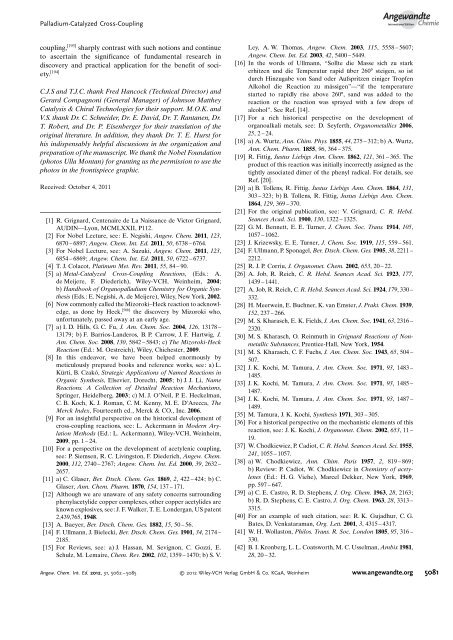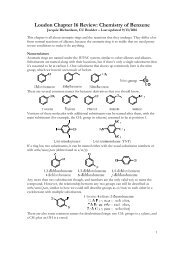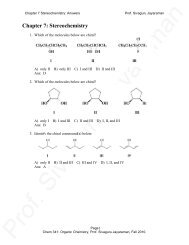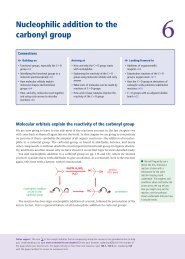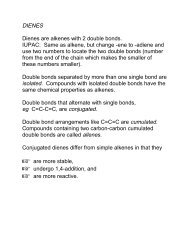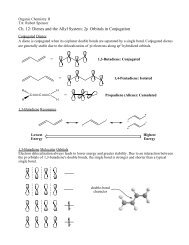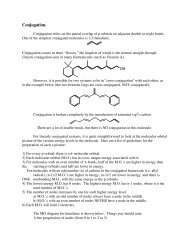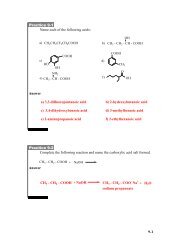Palladium-Catalyzed Cross-Coupling - A Historical Contextual Perspective to the 2010 Nobel Prize
Palladium-Catalyzed Cross-Coupling - A Historical Contextual Perspective to the 2010 Nobel Prize
Palladium-Catalyzed Cross-Coupling - A Historical Contextual Perspective to the 2010 Nobel Prize
You also want an ePaper? Increase the reach of your titles
YUMPU automatically turns print PDFs into web optimized ePapers that Google loves.
<strong>Palladium</strong>-<strong>Catalyzed</strong> <strong>Cross</strong>-<strong>Coupling</strong>AngewandteChemiecoupling, [193] sharply contrast with such notions and continue<strong>to</strong> ascertain <strong>the</strong> significance of fundamental research indiscovery and practical application for <strong>the</strong> benefit of society.[194]C.J.S and T.J.C. thank Fred Hancock (Technical Direc<strong>to</strong>r) andGerard Compagnoni (General Manager) of Johnson Mat<strong>the</strong>yCatalysis & Chiral Technologies for <strong>the</strong>ir support. M.O.K. andV.S. thank Dr. C. Schneider, Dr. E. David, Dr. T. Rantanen, Dr.T. Robert, and Dr. P. Eisenberger for <strong>the</strong>ir translation of <strong>the</strong>original literature. In addition, <strong>the</strong>y thank Dr. T. E. Hurst forhis indispensably helpful discussions in <strong>the</strong> organization andpreparation of <strong>the</strong> manuscript. We thank <strong>the</strong> <strong>Nobel</strong> Foundation(pho<strong>to</strong>s Ulla Montan) for granting us <strong>the</strong> permission <strong>to</strong> use <strong>the</strong>pho<strong>to</strong>s in <strong>the</strong> frontispiece graphic.Received: Oc<strong>to</strong>ber 4, 2011[1] R. Grignard, Centenaire de La Naissance de Vic<strong>to</strong>r Grignard,AUDIN—Lyon, MCMLXXII, P112.[2] For <strong>Nobel</strong> Lecture, see: E. Negishi, Angew. Chem. 2011, 123,6870 – 6897; Angew. Chem. Int. Ed. 2011, 50, 6738 – 6764.[3] For <strong>Nobel</strong> Lecture, see: A. Suzuki, Angew. Chem. 2011, 123,6854 – 6869; Angew. Chem. Int. Ed. 2011, 50, 6722 – 6737.[4] T. J. Colacot, Platinum Met. Rev. 2011, 55, 84 – 90.[5] a) Metal-<strong>Catalyzed</strong> <strong>Cross</strong>-<strong>Coupling</strong> Reactions, (Eds.: A.de Meijere, F. Diederich), Wiley-VCH, Weinheim, 2004;b) Handbook of Organopalladium Chemistry for Organic Syn<strong>the</strong>sis(Eds.: E. Negishi, A. de Meijere), Wiley, New York, 2002.[6] Now commonly called <strong>the</strong> Mizoroki–Heck reaction <strong>to</strong> acknowledge,as done by Heck, [56b] <strong>the</strong> discovery by Mizoroki who,unfortunately, passed away at an early age.[7] a) I. D. Hills, G. C. Fu, J. Am. Chem. Soc. 2004, 126, 13178 –13179; b) F. Barrios-Landeros, B. P. Carrow, J. F. Hartwig, J.Am. Chem. Soc. 2008, 130, 5842 – 5843; c) The Mizoroki-HeckReaction (Ed.: M. Oestreich), Wiley, Chichester, 2009.[8] In this endeavor, we have been helped enormously bymeticulously prepared books and reference works, see: a) L.Kürti, B. Czakó, Strategic Applications of Named Reactions inOrganic Syn<strong>the</strong>sis, Elsevier, Dorecht, 2005; b) J. J. Li, NameReactions. A Collection of Detailed Reaction Mechanisms,Springer, Heidelberg, 2003; c) M. J. ONeil, P. E. Heckelman,C. B. Koch, K. J. Roman, C. M. Kenny, M. E. DArecca, TheMerck Index, Fourteenth ed., Merck & CO., Inc. 2006.[9] For an insightful perspective on <strong>the</strong> his<strong>to</strong>rical development ofcross-coupling reactions, see: L. Ackermann in Modern ArylationMethods (Ed.: L. Ackermann), Wiley-VCH, Weinheim,2009, pp. 1 – 24.[10] For a perspective on <strong>the</strong> development of acetylenic coupling,see: P. Siemsen, R. C. Livings<strong>to</strong>n, F. Diederich, Angew. Chem.2000, 112, 2740 – 2767; Angew. Chem. Int. Ed. 2000, 39, 2632 –2657.[11] a) C. Glaser, Ber. Dtsch. Chem. Ges. 1869, 2, 422 – 424; b) C.Glaser, Ann. Chem. Pharm. 1870, 154, 137 – 171.[12] Although we are unaware of any safety concerns surroundingphenylacetylide copper complexes, o<strong>the</strong>r copper acetylides areknown explosives, see: J. F. Walker, T. E. Londergan, US patent2,439,765, 1948.[13] A. Baeyer, Ber. Dtsch. Chem. Ges. 1882, 15, 50 – 56.[14] F. Ullmann, J. Bielecki, Ber. Dtsch. Chem. Ges. 1901, 34, 2174 –2185.[15] For Reviews, see: a) J. Hassan, M. Sevignon, C. Gozzi, E.Schulz, M. Lemaire, Chem. Rev. 2002, 102, 1359 – 1470; b) S. V.Ley, A. W. Thomas, Angew. Chem. 2003, 115, 5558 – 5607;Angew. Chem. Int. Ed. 2003, 42, 5400 – 5449.[16] In <strong>the</strong> words of Ullmann, “Sollte die Masse sich zu starkerhitzen und die Temperatur rapid über 2608 steigen, so istdurch Hinzugabe von Sand oder Aufspritzen einiger TropfenAlkohol die Reaction zu mässigen”—“if <strong>the</strong> temperaturestarted <strong>to</strong> rapidly rise above 2608, sand was added <strong>to</strong> <strong>the</strong>reaction or <strong>the</strong> reaction was sprayed with a few drops ofalcohol”. See Ref. [14].[17] For a rich his<strong>to</strong>rical perspective on <strong>the</strong> development oforganoalkali metals, see: D. Seyferth, Organometallics 2006,25, 2 – 24.[18] a) A. Wurtz, Ann. Chim. Phys. 1855, 44, 275 – 312; b) A. Wurtz,Ann. Chem. Pharm. 1855, 96, 364 – 375.[19] R. Fittig, Justus Liebigs Ann. Chem. 1862, 121, 361 – 365. Theproduct of this reaction was initially incorrectly assigned as <strong>the</strong>tightly associated dimer of <strong>the</strong> phenyl radical. For details, seeRef. [20].[20] a) B. Tollens, R. Fittig, Justus Liebigs Ann. Chem. 1864, 131,303 – 323; b) B. Tollens, R. Fittig, Justus Liebigs Ann. Chem.1864, 129, 369 – 370.[21] For <strong>the</strong> original publication, see: V. Grignard, C. R. Hebd.Seances Acad. Sci. 1900, 130, 1322 – 1325.[22] G. M. Bennett, E. E. Turner, J. Chem. Soc. Trans. 1914, 105,1057 – 1062.[23] J. Krizewsky, E. E. Turner, J. Chem. Soc. 1919, 115, 559 – 561.[24] F. Ullmann, P. Sponagel, Ber. Dtsch. Chem. Ges. 1905, 38, 2211 –2212.[25] R. J. P. Corriu, J. Organomet. Chem. 2002, 653, 20 – 22.[26] A. Job, R. Reich, C. R. Hebd. Seances Acad. Sci. 1923, 177,1439 – 1441.[27] A. Job, R. Reich, C. R. Hebd. Seances Acad. Sci. 1924, 179, 330 –332.[28] H. Meerwein, E. Buchner, K. van Emster, J. Prakt. Chem. 1939,152, 237 – 266.[29] M. S. Kharasch, E. K. Fields, J. Am. Chem. Soc. 1941, 63, 2316 –2320.[30] M. S. Kharasch, O. Reinmuth in Grignard Reactions of NonmetallicSubstances, Prentice-Hall, New York, 1954.[31] M. S. Kharasch, C. F. Fuchs, J. Am. Chem. Soc. 1943, 65, 504 –507.[32] J. K. Kochi, M. Tamura, J. Am. Chem. Soc. 1971, 93, 1483 –1485.[33] J. K. Kochi, M. Tamura, J. Am. Chem. Soc. 1971, 93, 1485 –1487.[34] J. K. Kochi, M. Tamura, J. Am. Chem. Soc. 1971, 93, 1487 –1489.[35] M. Tamura, J. K. Kochi, Syn<strong>the</strong>sis 1971, 303 – 305.[36] For a his<strong>to</strong>rical perspective on <strong>the</strong> mechanistic elements of thisreaction, see: J. K. Kochi, J. Organomet. Chem. 2002, 653, 11–19.[37] W. Chodkiewicz, P. Cadiot, C. R. Hebd. Seances Acad. Sci. 1955,241, 1055 – 1057.[38] a) W. Chodkiewicz, Ann. Chim. Paris 1957, 2, 819 – 869;b) Review: P. Cadiot, W. Chodkiewicz in Chemistry of acetylenes(Ed.: H. G. Viehe), Marcel Dekker, New York, 1969,pp. 597 – 647.[39] a) C. E. Castro, R. D. Stephens, J. Org. Chem. 1963, 28, 2163;b) R. D. Stephens, C. E. Castro, J. Org. Chem. 1963, 28, 3313 –3315.[40] For an example of such citation, see: R. K. Gujadhur, C. G.Bates, D. Venkataraman, Org. Lett. 2001, 3, 4315 – 4317.[41] W. H. Wollas<strong>to</strong>n, Philos. Trans. R. Soc. London 1805, 95, 316 –330.[42] B. I. Kronberg, L. L. Coatsworth, M. C. Usselman, Ambix 1981,28, 20 – 32.Angew. Chem. Int. Ed. 2012, 51, 5062 – 5085 2012 Wiley-VCH Verlag GmbH & Co. KGaA, Weinheim www.angewandte.org5081


